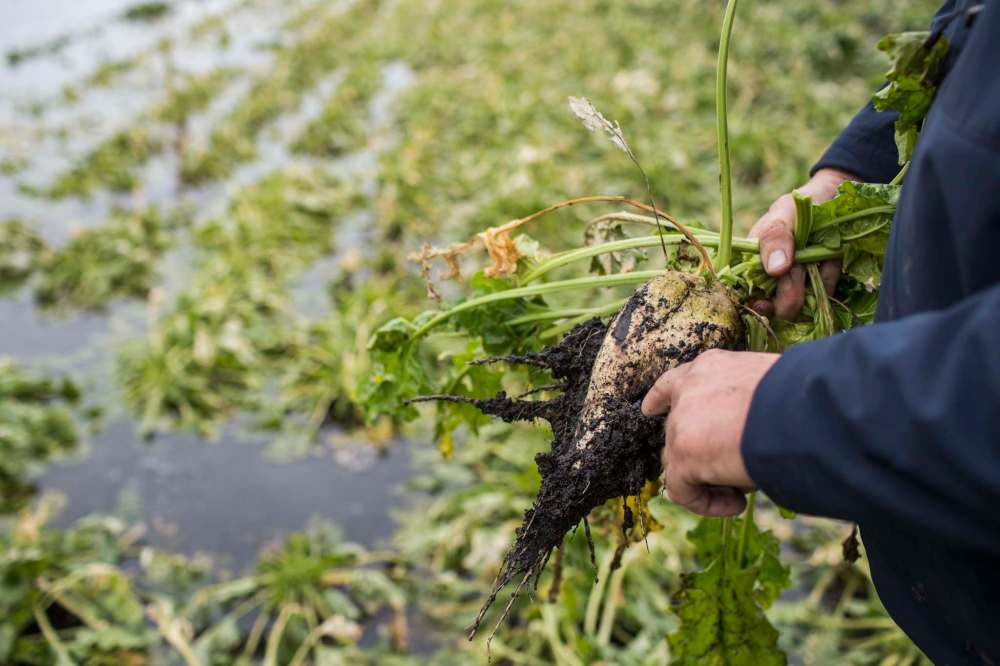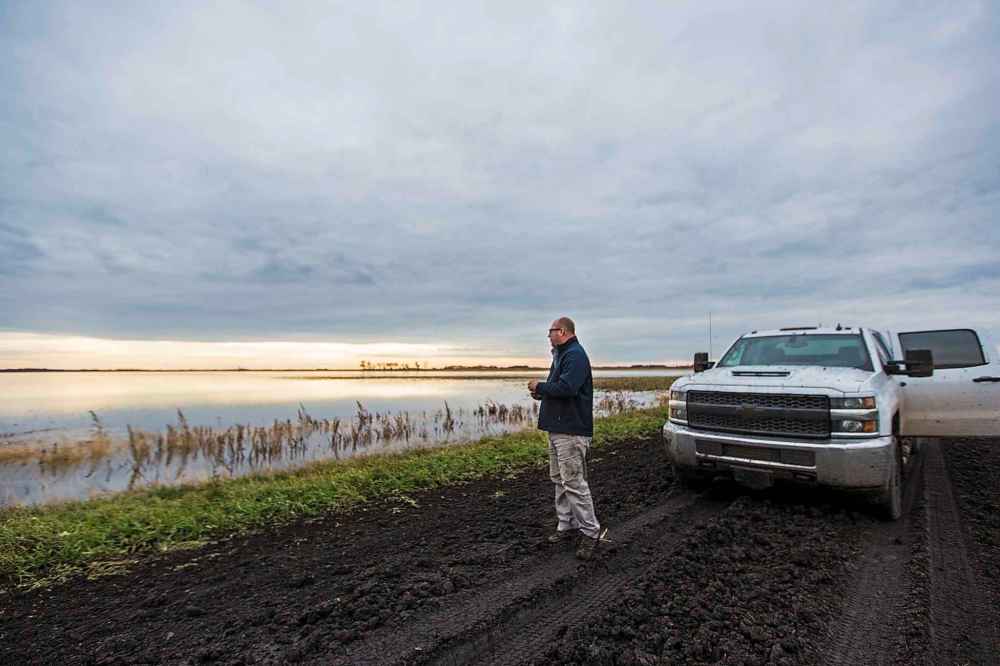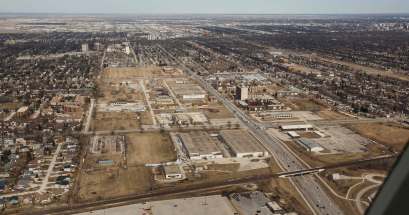Overflowed and under pressure Red River turns North Dakota farm fields into 'nightmare' as precipitation level raises fears for spring flood
Read this article for free:
or
Already have an account? Log in here »
To continue reading, please subscribe:
Monthly Digital Subscription
$0 for the first 4 weeks*
- Enjoy unlimited reading on winnipegfreepress.com
- Read the E-Edition, our digital replica newspaper
- Access News Break, our award-winning app
- Play interactive puzzles
*No charge for 4 weeks then price increases to the regular rate of $19.00 plus GST every four weeks. Offer available to new and qualified returning subscribers only. Cancel any time.
Monthly Digital Subscription
$4.75/week*
- Enjoy unlimited reading on winnipegfreepress.com
- Read the E-Edition, our digital replica newspaper
- Access News Break, our award-winning app
- Play interactive puzzles
*Billed as $19 plus GST every four weeks. Cancel any time.
To continue reading, please subscribe:
Add Free Press access to your Brandon Sun subscription for only an additional
$1 for the first 4 weeks*
*Your next subscription payment will increase by $1.00 and you will be charged $16.99 plus GST for four weeks. After four weeks, your payment will increase to $23.99 plus GST every four weeks.
Read unlimited articles for free today:
or
Already have an account? Log in here »
Hey there, time traveller!
This article was published 25/10/2019 (2238 days ago), so information in it may no longer be current.
MINTO, N.D. — Jay Gudajtes couldn’t help but cry when he pulled up to one of his sugar beet fields, a few kilometres from the Red River. It had hardly stopped raining or snowing lately, so what are a few more drops of water?
Gudajtes, a fourth-generation sugar beet farmer, was standing in front of the field — one of his largest — rubbing his hands over his eyes, awed by what lay before him, even though he’d already seen it: nearly every inch of the field was flooded, with a single island of beet leaves jutting out from the water.
A trio of geese were swimming where his beets were drowning, and where, in a drier October, his combine would be rolling along.
“I stand here, and I look out at this field, and that’s $200,000 I’m not going to get back. No chance there,” he said, barring a miracle. “Imagine taking every dollar you had, turning it into pennies, and individually placing them all over this land, hoping that in the fall, each cent will have turned into two. That second penny is going to pay for all the work you put in.”
Most of his pennies are now buried under several feet of water, and farmers all across the Red River Valley are hoping to recoup as many as they can.
These lakes were fields a few weeks ago. They were filled with hundreds of thousands of dollars worth of soya beans, pinto beans, sugar beets, sunflowers, and hay bales, buzzing with combines and tractors and farmers hoping to turn a profit after what had otherwise been a dry summer.
Now: water everywhere and not a crop to be seen.

Gudajtes’ family has been farming in the Red River Valley for 107 years, on land located between Minto and Warsaw, a community just off Interstate Highway 29 founded by Polish immigrants, including his great-great grandfather. It’s a community whose fate and fortune are determined by farming, and many of the nearby farmers are at the mercy of the mighty Red.
Like Manitoba, North Dakota has been hit with a devastating combination of fall weather events.
First, a massive rainfall in mid-September, followed by a historic October snowfall, combining to create the wettest fall in the U.S. state’s history. The Red, which flows north to Manitoba and passes through dozens of small towns, rose to unprecedented levels as a result.
In Grand Forks to the south, the river reached 41 feet — more than 10 higher than the previous record for this time of year. Gov. Doug Burgum declared a state of emergency Monday to free up federal resources to deal with damaged infrastructure and potential flooding.
In Winnipeg, the Red crested at more than 17 feet, and the province has issued a high-water advisory for the city and communities along the river.
“Imagine taking every dollar you had, turning it into pennies, and individually placing them all over this land, hoping that in the fall, each cent will have turned into two. That second penny is going to pay for all the work you put in.”
– North Dakota farmer Jay Gudajtes
The levels have begun to decrease, and while Winnipeg and Grand Forks aren’t too concerned about major damage or evacuation, the river is so high along the stretch of North Dakota land between Drayton and Minto it has overflowed the banks and overtaken thousands of acres of fields that abut the basin.
“No matter where you live, you have lakefront property,” said Erika Martens, mayor of nearby Oslo, which straddles the Minnesota-North Dakota border.

The river’s height and the moisture of the soil are in the 95th percentile or higher for this time of year, said Greg Gust, a warning co-ordination meteorologist with the U.S. National Weather Service based in Grand Forks.
Those are two of the ingredients for a spring flood, he said, along with freeze, snowfall, thaw, and spring rains.
What happens in North Dakota doesn’t stay in North Dakota: the Red runs north through Manitoba, and if the other ingredients are added to the mix, there is a possibility of a major spring flood along the river.
“Never in the history of this state have we seen conditions like this at this time of year,” Cody Schulz, the state’s director of Homeland Security, said Thursday. “Our concern levels are high.”
For farmers such as Gudajtes, that’s a massive understatement.
● ● ●
Gudajtes Family Farm is hard to miss: its silos and outbuildings tower over the flat prairie land, and its trucks whip up and down the country roads from field to field as its staff does its best to harvest whatever it can.
In the farm office, Jay Gudajtes sits at his desk, where he’s had to spend more time than he’d like recently: the fields have been too wet, and the roads have often been flooded.
“Harvest is always a stressful time,” said Gudajtes, 43, who runs the 20,000-acre farm with his father, John, and brother, Lee. However, he’s never seen a harvest quite as tough as this one.

Across the state, an estimated US$5 billion in crops were still out in the fields, and sugar beets, the cornerstone of the Gudajtes business, were one of the hardest-hit. In Manitoba, about 77 per cent of the harvest was completed by Friday.
His farm was one of the fortunate ones, relatively speaking: while some farmers have huge percentages of their land unharvested, sometimes as much as two-thirds, Gudajtes had only 12 per cent of his crop left out in the field. That 12 per cent includes about 575 acres of sugar beets, at an estimated value of $1,000 per acre.
But the outlook for those plants is grim. The Red River has overflowed and flooded each acre, and wherever soil can be seen, it’s far too muddy for farm equipment to do an effective job: tractors are used to pull trucks off the road and across the ditches, and even the most well-built pick-up is no match. Gudajtes’ bumper has already been torn off his Chevy twice.

“It’s a nightmare, huh?” asked a neighbour driving past Gudajtes along a bumpy field. They both belong to a farming collective that sits about US$3 million short of its target revenue for 2019.
Gudajtes nodded, and continued to check on his fields, hoping things had improved since he did the same thing a day earlier.
He pulled over on the side of County Road 17, where a bridge divided North Dakota and Minnesota. On either side, there was devastation. The river was about 39 feet high, and fallen trees drifted by as the water rushed at 45,000 cubic feet per second.
The sight was truly remarkable: the river poured over the banks and overtook land as far as Gudajtes could see. The next nearest road was about 26 km away, and the entire expanse was coated in water.
Throughout the day, as he drove around what should be bustling farmland, Gudajtes held strong. But standing beside his flooded field, and across from one with water so deep he couldn’t even see what was growing there, he broke down.
“No matter where you live, you have lakefront property.”
– Erika Martens, mayor of Oslo, Minnesota
This wasn’t just affecting his family, but neighbours and friends, some of whom might not be able to recover.
“Maybe I’ll get this crop off, but it doesn’t seem like I will today,” he added. “I might never get it.”
No matter how hard farmers work, it doesn’t always make a difference: the Red can dictate fortunes and destroy livelihoods. Could more destruction be on the way, and could it reach Manitoba next spring?

It’s too early to tell, said climatologist Danny Blair, co-director of the Prairie Climate Centre at the University of Winnipeg, who called this fall’s precipitation level a significant anomaly and a part of a long-term regional trend toward increased wetness.
“The extreme events that are spring floods are a consequence of several things lining up in just the wrong way,” he said. So far, the soil being heavily saturated and the river’s elevated height are points of worry, but a lot of variables related to freeze and melt are too far off to accurately project.
“Uncertainty is normal for our climate, and even more so in our future climate,” Blair said. “Who knows what’s coming next winter and next spring?”
Thomas Inocencio, commander of North Dakota’s northeast regional water operations team, agreed it’s too early to sound the alarm. “But the conditions right now are probably least favourable going into winter,” he said. “We’re certainly hoping for a slow melt in the spring.”
The North Dakota government isn’t taking any chances, Schulz from Homeland Security said. Normally, the department begins planning for spring flooding in January. This year, it’s starting in November.
As for Gudajtes, he’s focused on recovering what he can before the snow falls. He’ll worry about spring when it arrives.
ben.waldman@freepress.mb.ca


Ben Waldman covers a little bit of everything for the Free Press.
Our newsroom depends on a growing audience of readers to power our journalism. If you are not a paid reader, please consider becoming a subscriber.
Our newsroom depends on its audience of readers to power our journalism. Thank you for your support.










